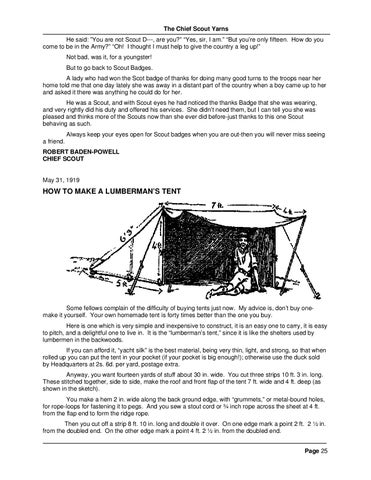The Chief Scout Yarns He said: ”You are not Scout D---, are you?” “Yes, sir, I am.” “But you’re only fifteen. How do you come to be in the Army?” “Oh! I thought I must help to give the country a leg up!” Not bad, was it, for a youngster! But to go back to Scout Badges. A lady who had won the Scot badge of thanks for doing many good turns to the troops near her home told me that one day lately she was away in a distant part of the country when a boy came up to her and asked it there was anything he could do for her. He was a Scout, and with Scout eyes he had noticed the thanks Badge that she was wearing, and very rightly did his duty and offered his services. She didn’t need them, but I can tell you she was pleased and thinks more of the Scouts now than she ever did before-just thanks to this one Scout behaving as such. Always keep your eyes open for Scout badges when you are out-then you will never miss seeing a friend. ROBERT BADEN-POWELL CHIEF SCOUT
May 31, 1919
HOW TO MAKE A LUMBERMAN’S TENT
Some fellows complain of the difficulty of buying tents just now. My advice is, don’t buy onemake it yourself. Your own homemade tent is forty times better than the one you buy. Here is one which is very simple and inexpensive to construct, it is an easy one to carry, it is easy to pitch, and a delightful one to live in. It is the “lumberman’s tent,” since it is like the shelters used by lumbermen in the backwoods. If you can afford it, “yacht silk” is the best material, being very thin, light, and strong, so that when rolled up you can put the tent in your pocket (if your pocket is big enough!); otherwise use the duck sold by Headquarters at 2s. 6d. per yard, postage extra. Anyway, you want fourteen yards of stuff about 30 in. wide. You cut three strips 10 ft. 3 in. long. These stitched together, side to side, make the roof and front flap of the tent 7 ft. wide and 4 ft. deep (as shown in the sketch). You make a hem 2 in. wide along the back ground edge, with “grummets,” or metal-bound holes, for rope-loops for fastening it to pegs. And you sew a stout cord or ¾ inch rope across the sheet at 4 ft. from the flap end to form the ridge rope. Then you cut off a strip 8 ft. 10 in. long and double it over. On one edge mark a point 2 ft. 2 ½ in. from the doubled end. On the other edge mark a point 4 ft. 2 ½ in. from the doubled end. Page 25
